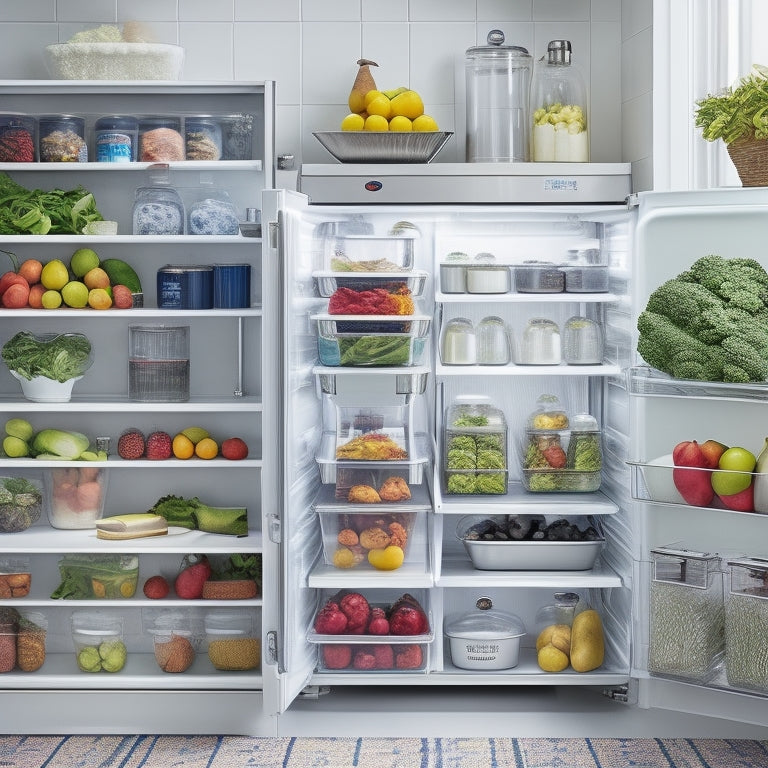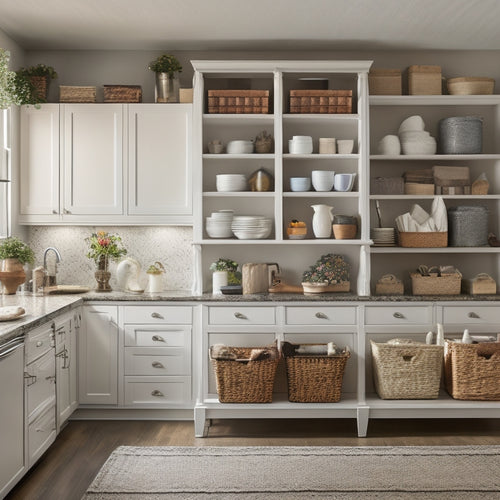
Mastering Proper Storage for Food Safety
Share
Proper storage is a crucial component of a thorough food safety plan, as it helps prevent contamination, spoilage, and pest infestation, ensuring that food products remain safe for consumption throughout the entire supply chain. Effective storage involves segregating chemicals from food products, maintaining a well-organized dry storage area, and implementing proper cleaning and sanitizing procedures. Additionally, pest control measures, temperature control, and humidity monitoring are essential in preventing contamination and spoilage. By following these guidelines, food establishments can greatly reduce the risk of foodborne illnesses. Learn how to develop a robust storage plan that safeguards public health.
Key Takeaways
• Separating chemicals from food products and following manufacturer instructions is crucial for preventing cross-contamination and maintaining a safe storage environment.
• Organizing dry storage areas by segregating chemicals, labeling products, and rotating stock regularly helps prevent spoilage and ensures easy identification.
• Effective cleaning and sanitizing procedures, including proper disinfection techniques and surface-specific protocols, prevent pathogen spread and maintain a clean environment.
• Implementing pest control measures, such as sealing cracks and crevices, storing goods in pest-proof containers, and regular inspections, prevents contamination from rodents and cockroaches.
• Maintaining a safe storage environment requires careful attention to detail, including temperature control, humidity monitoring, and regular cleaning schedules to prevent expired products and ensure consumer health.
Chemical Storage and Handling
Proper chemical storage and handling is crucial in preventing cross-contamination and ensuring food safety. It involves separating chemicals from food products and adhering to manufacturer instructions. Chemical handling and storage procedures are vital components of a food safety plan.
To maintain a safe environment, store foods and chemicals separately. Chemicals should be stored below and away from foods. Properly label chemicals and use them according to manufacturers' instructions. Only necessary chemicals for operations and maintenance should be present, and they should be used for cleaning and sanitizing purposes.
Dry Storage and Organization
In addition to segregating chemicals from food products, maintaining a well-organized dry storage area is vital for preventing contamination and ensuring the quality of stored goods. Proper labeling is essential, allowing for easy identification and retrieval of products.
Inventory management is also key, ensuring that stock is rotated regularly and expired or damaged items are removed. This helps prevent cross-contamination and reduces the risk of spoilage.
Cleaning and Sanitizing Essentials
Effective cleaning and sanitizing procedures are essential elements of a thorough food safety program. They help prevent the spread of pathogens and reduce the risk of foodborne illnesses. To guarantee a clean and sanitized storage environment, it's imperative to follow proper protocols.
-
Use effective cleaning methods and proper disinfection techniques to remove dirt, grime, and microorganisms.
-
Implement sanitizing protocols that cater to different surfaces and contaminants.
-
Choose the right cleaning supplies for the job, and always follow the manufacturer's instructions.
- Train staff on proper cleaning and sanitizing techniques to ensure consistency and efficacy.
Pest Control and Prevention
Pests, including rodents, cockroaches, and flies, can contaminate food and surfaces, posing significant risks to food safety and public health. To prevent these unwanted visitors, it's vital to implement effective pest control measures.
Rodent exclusion is key, so seal those cracks and crevices around your storage area. Store food and goods in pest-proof containers, and regularly inspect your storage space for signs of pests. A licensed professional can help you develop a pest control program tailored to your needs.
Maintaining a Safe Storage Environment
Maintaining a safe storage environment requires careful attention to detail, as improperly stored food and goods can pose significant risks to consumer health and safety. A well-maintained storage space is vital in preventing contamination, spoilage, and pest infestations.
To achieve this, it is important to:
-
Implement temperature control and humidity monitoring to maintain ideal storage conditions
-
Practice stock rotation and inventory management to avoid expired or spoiled products
-
Ensure proper labeling and organization of goods to facilitate easy tracking and identification
- Perform regular cleaning and sanitizing schedules to prevent the buildup of dirt and bacteria
Frequently Asked Questions
What Are the Consequences of Not Following Proper Food Storage Guidelines?
Failing to adhere to proper food storage guidelines can have severe consequences. The most critical outcome is the risk of foodborne illnesses, which can lead to serious health issues and even fatalities.
Additionally, economic consequences can be devastating, including costly product recalls, lawsuits, and damage to a business's reputation.
How Often Should I Inspect My Storage Areas for Potential Hazards?
Imagine a storage area gone rogue - a breeding ground for bacteria, pests, and contamination!
To avoid this nightmare, regular audits are essential. Conduct seasonal checks to catch potential hazards before they spiral out of control.
Quarterly, inspect for signs of pest infestation, expired products, and equipment malfunctions.
Monthly, review storage layouts and labeling.
Can I Reuse Cleaning and Sanitizing Solutions to Save Money?
Reusing cleaning and sanitizing solutions may seem like a cost-effective measure, but it's a recipe for disaster. Not only can it compromise the effectiveness of the solutions, but it can also lead to the growth of harmful bacteria and contaminants.
This approach may save you a few bucks in the short term, but it can have devastating environmental and health impacts in the long run. It's better to prioritize proper sanitation and hygiene practices, even if it means investing in fresh solutions.
Are There Any Food Safety Regulations Specific to My State or Region?
When it comes to food safety regulations, it is vital to familiarize yourself with local ordinances and regional codes specific to your area. These regulations may vary from state to state, so it is important to stay informed.
For instance, you can start by checking with your local Environmental Public Health department, such as the one in Port Townsend, WA, to understand the specific guidelines and requirements in your region.
What Is the Best Way to Keep My Staff Trained on Food Safety Procedures?
'An ounce of prevention is worth a pound of cure.'
When it comes to food safety, staff training is essential. To keep your staff up-to-speed, try incorporating staff incentives, such as recognition or rewards for completing training modules.
Make it engaging with training games that simulate real-life scenarios. This approach not only guarantees compliance but also fosters a culture of accountability and teamwork.
Related Posts
-

3 Essential Tips to Boost Home Storage Capacity
You're one step away from freeing yourself from clutter chaos! To boost your home storage capacity, start by purging ...
-

3 Best Online Courses for Home Organization Skills
You're just a few clicks away from a clutter-free home and a more efficient daily routine. Three online courses can h...

